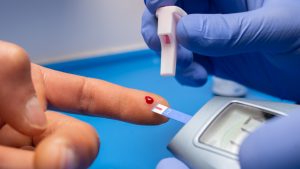Type 2 diabetes, a chronic condition affecting millions worldwide, is characterized by elevated blood sugar levels (glucose) due to insulin resistance or the body’s inability to produce enough insulin. While there’s no cure for type 2 diabetes, adopting a vegan diet can be a potent tool in managing the disease and improving quality of life.

Why is a vegan diet beneficial for type 2 diabetes?
Lowers blood sugar levels: Vegan foods, especially fruits, vegetables, legumes, and whole grains, are rich in fiber and low in added sugars and saturated fats. Fiber helps slow down the absorption of sugar into the bloodstream, aiding in better blood sugar control.
Promotes weight loss: Type 2 diabetes is often associated with overweight or obesity. A vegan diet, being naturally low in calories and high in fiber, can help with weight loss and maintaining a healthy weight, thus improving blood sugar control and reducing the risk of complications.
Reduces the risk of heart disease: Individuals with type 2 diabetes are at increased risk of heart disease. A vegan diet, rich in fiber, antioxidants, and unsaturated fats, can help lower LDL (“bad”) cholesterol and raise HDL (“good”) cholesterol, thereby decreasing the risk of heart disease.
Improves insulin sensitivity: A vegan diet can help improve insulin sensitivity, meaning the body uses insulin more efficiently to control blood sugar levels.
Lowers blood pressure: High blood pressure is a common risk factor for people with type 2 diabetes. A vegan diet, being high in potassium and low in sodium, can help reduce blood pressure.
Examples of a vegan diet for type 2 diabetes:
Breakfast:
- Oatmeal with fresh fruit, nuts, and chia seeds.
- Whole grain toast with avocado and tomato.
- Fruit smoothie with plant-based milk and vegan protein powder.
Lunch:
- Chickpea salad with vegetables and lemon vinaigrette.
- Lentil and quinoa vegetarian chili.
- Whole wheat pasta with tomato sauce and sautéed vegetables.
Dinner:
- Stir-fried tofu with vegetables and brown rice.
- Stewed lentils with whole wheat bread.
- Vegetarian burgers with green salad.
Snacks:
- Fresh fruit.
- Raw vegetables with hummus.
- Nuts and seeds.
- Plant-based yogurt with granola.
Additional recommendations:
- Consult with a healthcare professional or vegan nutritionist to create a personalized meal plan that suits your needs and preferences.
- Read nutrition labels carefully and choose products low in added sugars, saturated fats, and sodium.
- Cook your own meals with fresh ingredients and spices instead of salt.
- Opt for natural seasonings like herbs (basil, oregano, rosemary) and spices (black pepper, turmeric, cumin).
- Choose fresh vegetables and fruits, which are naturally low in sodium and rich in potassium, a mineral that helps control blood pressure.
Tips for a gradual transition to a vegan diet:
- Start by replacing one or two meals a week with vegan options.
- Experiment with new vegan recipes and alternative foods.
- Learn about vegan nutrition to ensure you’re getting all the necessary nutrients.
- Seek support from online vegan groups or your local community.
Studies on vegan diet and type 2 diabetes:
- Effects of a vegan diet on glycemic control in patients with type 2 diabetes
- Impact of a vegan diet on cardiovascular risk factors in individuals with type 2 diabetes
- Association between vegan diet and reduced insulin resistance in adults with type 2 diabetes
- Long-term effects of a vegan diet on type 2 diabetes control and metabolic health
Remember: A vegan diet can not only help control type 2 diabetes but also improve overall health and reduce the risk of other chronic diseases. It’s time to make a positive change in your life and health!

Type 2 Diabetes: Is It Really Reversible?
A recent National Geographic article [link] explores how type 2 diabetes could be reversible with the right approaches. This condition, which affects millions of people worldwide, has long been considered a chronic and progressive disease. However, recent research challenges this perception and suggests that with lifestyle changes and the right approach, remission is possible. The

How Do GLP-1 Drugs Compare? A Breakdown of Ozempic, Mounjaro, and Trulicity
GLP-1 receptor agonists have revolutionized diabetes management, with drugs like Ozempic, Mounjaro, and Trulicity leading the market. But how do these medications compare in terms of effectiveness, side effects, and patient outcomes? Let’s explore their differences and what they mean for diabetes patients. Understanding GLP-1 Medications GLP-1 receptor agonists mimic a natural hormone that helps

Why Has Medicare Spending on Diabetes Medications Skyrocketed in 5 Years?
In the past five years, Medicare spending on diabetes medications has increased nearly fivefold, reaching $35.8 billion in 2023. This surge has been primarily driven by the growing use of GLP-1 drugs such as Ozempic, Mounjaro, and Trulicity. But what is behind this cost escalation, and how does it affect patients and the U.S. healthcare

The Gut Microbiota and Blood Sugar Control: A Hidden Connection
The human gut is home to trillions of bacteria that play a crucial role in digestion, immune function, and even metabolism. Recent research has revealed a fascinating link between the gut microbiota and blood sugar regulation, shedding light on how the balance of microbes in our intestines can influence diabetes risk and overall metabolic health.

The Dawn Phenomenon: Why Blood Sugar Rises While You Sleep
For many people with diabetes, waking up with high blood sugar levels can be frustrating—especially if they didn’t eat anything overnight. This early-morning spike in blood glucose is known as the Dawn Phenomenon, and it happens due to natural hormonal changes in the body. But why does it occur, and how can it be managed?

The Influence of Red Light on Blood: Can It Improve Diabetes?
Type 2 diabetes is a metabolic disease characterized by insulin resistance and elevated blood glucose levels. In the search for complementary alternatives to improve glycemic control, red light therapy has gained attention due to its potential to enhance circulation, reduce inflammation, and optimize cellular function. But what does science say about it? ✨ What is

